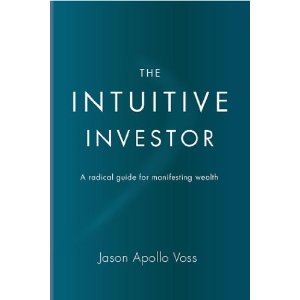 So the day after I was laid off, this book called “The Intuitive Investor” shows up. Pretty good timing, I’d say. And while the topic would not be one I would normally pick up, I was especially intrigued by the combination of intuition and investment because, well, now I am back to being poor and could use all the financial advice I could get. So I decided to interview the author, Jason Apollo Voss. Here he is!
So the day after I was laid off, this book called “The Intuitive Investor” shows up. Pretty good timing, I’d say. And while the topic would not be one I would normally pick up, I was especially intrigued by the combination of intuition and investment because, well, now I am back to being poor and could use all the financial advice I could get. So I decided to interview the author, Jason Apollo Voss. Here he is!
1. While I understand intellectually how one needs to invest with the right and left brain, I need to know how exactly you get the two parts of your brain to work in tandem. My two brains like flipping each other the bird. How can I make them get along?
The short answer is to increase your consciousness about how you are making decisions. This is because scientifically it has been consistently demonstrated that there is no true physical distinction between the left and right brains.
The very famous left-right brain language that has permeated our culture only holds true physically in schizophrenics and other special cases. So the left brain and right brain are always functioning in tandem – there is no separation. However, the left-right distinctions remain useful for describing distinct brain functions.
I think what you are asking about though is how to have greater balance between your brain’s left-right functions. One answer is to bring greater consciousness to any preferences you have for one “side” of your brain versus the other side.
It’s likely that at the root your preferences are emotionally driven. Perhaps you received moving praise for doing well in math when you were very young. Or perhaps it was a situation like having difficulty with learning or doing math when you were younger. This led to feeling ignorant so perhaps you stopped enjoying mathematics.
Alternatively, it could be that your brain does well with left brain and right brain thinking but that you are unconscious of the ways in which some of the aspects of your brain functions are operating and at all times.
For example, when people are about to make an important financial decision they often gather a lot of facts to assist their decision. To most people this looks like an exclusively left brain activity, yet the right brain provides the discernment function that allows you to choose which facts to focus on from amongst an infinite sea of information. That is, the right brain helps you to know which facts are important.
The right brain helps you to answer why you prefer certain facts over others. Most people are unconscious of the fact that this process is equal parts right brain and left brain. To wrap it up, your mind works in a holistic fashion, what may be missing is a conscious appreciation for its holistic nature.
2. You mention fear a lot. How best do we overcome fear so that we can listen to our intuition?
To be clear, I spend lots of time discussing fear and anxiety. Again, in short, the answer is to bring conscious awareness to our feelings. Those moments when we are experiencing feelings of fear it is important to take a deep breath and feel into what we are really experiencing. Overwhelmingly what most of us call fear is really anxiety.
In Gavin de Becker’s excellent book “The Gift of Fear” he talks about real fear being moments of stark clarity. If you have ever had a car accident or something similar where time seems to massively slow down and all details are apparent and easy to negotiate, this is real fear.
When you experience this sensation when making an investment decision, it is something to certainly acknowledge. This is the intuition in high operation and good decisions are made in these circumstances. In my nearly two decades investment career I have only experienced real fear twice.
Most of the time what we are experiencing when we think we are experiencing fear is anxiety. This anxiousness is brought on by the memory of a similar investment situation or decision in which things didn’t go the way we wanted it to go.
But these moments are also extremely valuable as they indicate having reached a personal boundary. In these moments it is important to take a moment to assess what we are really bothered by in the moment.
That’s because good decisions are usually not made in the presence of anxiousness. One technique is to objectify your feelings of anxiety, perhaps by imagining them as a dark empty room. Turning your feelings into a symbol allows you to hopefully think about them, rather than feel them.
Once you can think about them I encourage folks to try and examine the source of their feelings of anxiety. Even if the source cannot be identified it is important to reassure yourself that you are, in fact, quite safe in the current moment. That is, your life is not in jeopardy. Once you feel safe you can begin to make your decision, hopefully, with less anxiousness and more clarity.
3. I appreciate your seven essential attitudes. Could you give a two-sentence description of each for the reader?
Of course, and thank you for asking about them. Here they are in order:
1. Focus on risks before opportunities.
Investment risks repeat themselves over and over again and so are somewhat predictable. Whereas, opportunities are very difficult to predict. So when investing, focus on risks before focusing on opportunities.
2. Comfort with uncertainty.
Investment results are always uncertain. To avoid unnecessary anxiety you need to harmonize with this fact. In other words, you need to gain comfort with the uncertainty of investing.
3. A good decision is most often greater than or equal to the “best” decision.
The “best” decision is only knowable by looking back at your choices. But investing is about making choices about the future. Obsessing about making the “best” decision usually leads to brain lock and indecision. Better to focus on making a good investment decision from amongst the many uncertain possibilities.
4. Forgive yourself for not being perfect.
Eventually you will make an investment mistake. Don’t worry about this. Instead, see it as a learning opportunity. History demonstrates that good investor’s only get it right 6-7 times out of 10. So forgive yourself for not being perfect.
5. You are holding investment interviews.
When investing you have the power, not the investment. Think of investing as you holding interviews for a position within your portfolio – the job of the investment is to make you money. This puts you in the command position and gives you permission to say “no” if you are not comfortable with the candidate for the job.
6. Why does it have to be this one?
There are 10,000 U.S. stocks and around 10,000 or so mutual funds. So if you are about to make an investment decision treat “maybes” as “nos.” Ask yourself: why is this investment The One? If it’s
not, there are 9,999 others to consider.
7. Beware false prophets.
False prophets take the form of the hype, both positive and negative, that surrounds some investments. That hype takes on many forms but beware of investments whose story is told with lots of adjectives. Adjectives like: the best, the shining star, super star, perennial performer, the worst, troubled, disappointing, and so forth. You want to process is investment reality, not a journalist’s mythological rendering of investment reality.
* Click here to subscribe to Beyond Blue and click here to follow Therese on Twitter and click here to join Group Beyond Blue, a depression support group. Now stop clicking.

